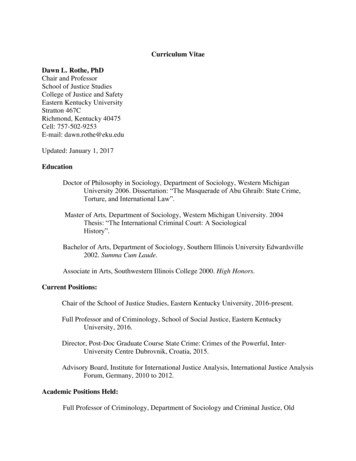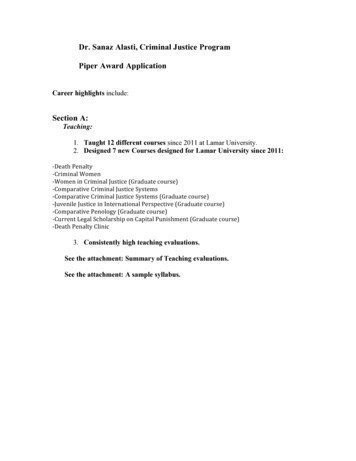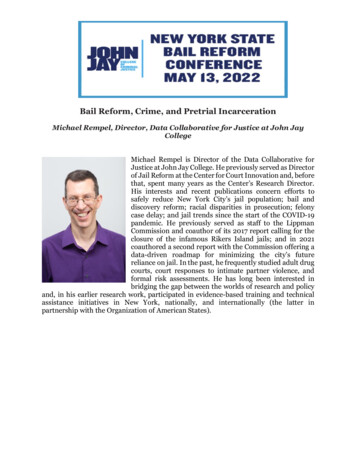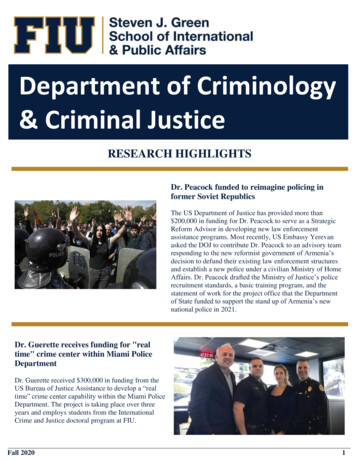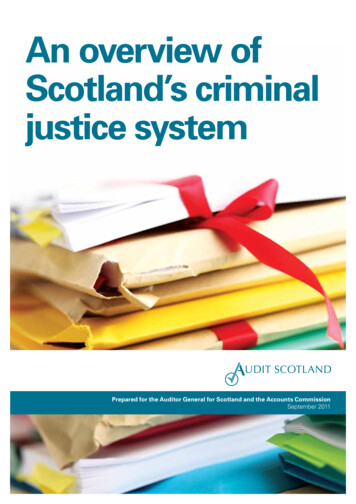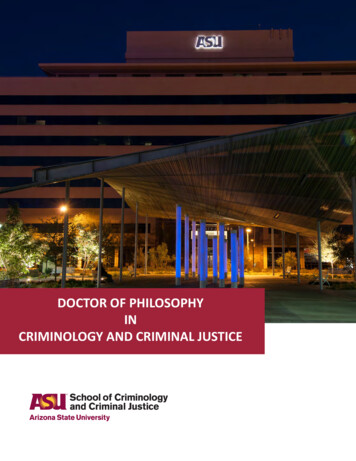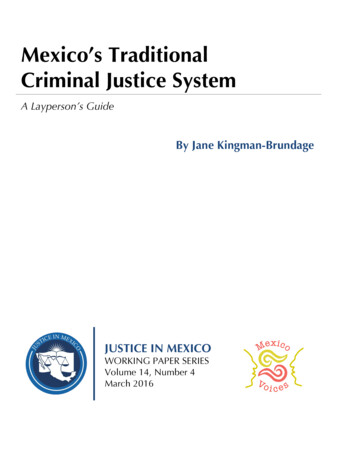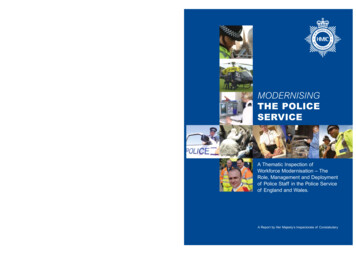
Transcription
5570-HO-Modernising Pol-COV19/7/0412:34 pmPage 1MODERNISING THE POLICE SERVICE Crown CopyrightHer Majesty’s Inspectorate of ConstabularyMODERNISINGTHE POLICESERVICEA Thematic Inspection ofWorkforce Modernisation – TheRole, Management and Deploymentof Police Staff in the Police Serviceof England and Wales.First published in July 2004 by HMIC50 Queen Anne’s Gate, London SW1H 9ATISBN 1-84473-294-0This report can also be viewed on the Home Office website www.homeoffice.gov.ukA Report by Her Majesty’s Inspectorate of Constabulary
AcknowledgementsChapter ISummary of Key Findings and Recommendations Overview Cultural issues Chapter IIChapter IIIStrategy, policy and planningFinanceRole of national bodiesPerformance managementManagement and deployment of police staffPolice reform and the extended policing familyPossible future police staff rolesThe futureSummary of recommendations1111121313141517171819Introduction Background and rationale for the inspection Key terms Police officer and police staff Civilianisation Mixed economy Workforce modernisation Key drivers for change Scope and terms of reference Inspection methodology Report structure Anticipated key outcomes from the inspection2829293132323334353536Historical and Comparative Analysis The role of police staff in the police service of Englandand Wales from 1829 to the present day38 Stage 1 – 1829 – 1938 Stage 2 – 1939 – 1959 Stage 3 – 1960 – 1982 Stage 4 – 1983 – 2004 Key issues and themes The role of police staff in police forces outsideEngland and Wales North America New Zealand Australia3838383942434345461Table of ContentsForeword by Sir Keith Povey QPM BA (Law), HM Chief Inspector of Constabulary
MODERNISING THE POLICE SERVICE Chapter IVChapter V2Europe Key issues and themes Modernisation in other occupational sectors Education Health Legal services Prison Service Probation Service Fire Service HM Customs & Excise UK Immigration Service4647484848494950505151Cultural Issues – “What does it feel like to be a policestaff member?” Introduction Key issues Management of specialist departments Impact of funding Terms and conditions Cultural acceptance Diversity issues Findings from research Supervision Likelihood of industrial action Public perception Officer perception of police staff contribution Openness to change UNISON Survey 20025454545555565657575758585959Police Service Strategy, Funding and Performance Management Overview National strategic framework Vision Tri-partite structure Funding Crime Fighting Fund Impact of the CFF on officer numbers Balancing efficiency with modernisation Back office Productive time Reduction in front-line supervision and management Management of police staff646465656667677070707072
Table of Contents Role of the Home OfficeRole of police authoritiesRole of ACPOA Modernisation AgencyStrategic approach at force levelLocal policingThe police rolePerformance management The Policing Performance Assessment Framework Front-line policing measurement Tracking the release of officers Benchmarking Evaluation73737474757677787879818283People Issues – the role, management and deploymentof police staff Achieving the right mix of skills Overview Variations in staffing mix Staffing mix in specific policing functions Civilianisation initiatives The Workforce Modernisation Implementation Fund Utilising the life skills of the workforce Operational resilience Skills, standards and accreditation Skills for Justice A framework for integrated people management Recruitment and retention of police staff Overview Terms and conditions Police staff recruitment Retention of staff Emerging career structures Variations in police staff pay Job evaluation Training and development Overview The role of Centrex Highlighting ‘high potential’ police staff Leadership training – Strategic Command 06108108108109109110 Chapter VI3
MODERNISING THE POLICE SERVICE Leadership training – Senior LeadershipDevelopment Programme Leadership training – Core LeadershipDevelopment Programme A learning requirement for the police service Community Support Officer training Training and development at force level Investment in police staff training and development Staffing of the training functionCareer development and career pathways Overview A modular framework of career pathways Summary of ACPO/NCPE work Building a flexible employment framework Building a representative workforceLeadership and senior appointments Overview Police staff representation on force command teams ACPO membershipDeveloping senior police staff leadersConsultation and representation Trade unions and staff associations National consultation Police Staff Council Local consultation and communicationUse of retired police officers Agencies supplying retired officers Employment of retired officers by forcesImpact of the Disability Discrimination Act Overview Preparations for the ActManaging recuperative and restricted dutiesChapter VII Police Reform and the Extended Policing Family Overview Special Constabulary Overview Special Constabulary strength Payment Impact of the Special Constabulary on theextended policing 137137138139139
Table of Contents Innovative practice Liaison with employersThe Police Reform Act 2002Community Support Officers Overview Take-up of CSO funding Evaluation and impact Designation of powers Partnership issues Managing growth Uniform and equipment Management of CSOs Risk assessment Diversity Developing guidance for forces on CSOsCommunity Safety Accreditation Schemes Overview Benefits of accreditationNeighbourhood wardens and street wardensDetention officers Overview Private sector detention and custody servicesVolunteersPolice staff investigators Overview Training and accreditation Professionalising the investigation processPrivate sector involvement in policingOther public sector involvementPublic perception of the extended policing family Marketing the concept Engaging with communitiesPossible future police staff roles Patrol, detention, investigation and response to incidents Road policing Custody roles Police use of firearms – static protection duties Extension of Special Constabulary 64165167167168168169 169Cross-cutting roles5
MODERNISING THE POLICE SERVICEChapter VIII The Future Introduction Some unresolved questions Is the traditional role and status of a constable still relevant? Can the service remain isolated from modernemployment trends? Is it time for more national standards? Are force structures and hierarchies now counterproductive? Can policing learn more from other public services? Should the private sector play an even greater role in policing? What is the optimum balance of police officers and other staff? The model police force for the future? Police service role National context Force structures Service delivery options Employment conditions Police powers Core capabilities (career paths) Mixed economy of staffing Funding experimentation 183184184185185186187Glossary of Abbreviations used in Main Report189Appendices – available in electronic format only, downloadable from HMIC website –www.homeoffice.gov.uk/hmic/pubs.htmAppendix A Terms of ReferenceAppendix B Inspection MethodologyAppendix C Selected References and BibliographyAppendix D List of Abbreviations used in Main Report and AppendicesAppendix E Reference Group MembersAppendix FPolice Officer and Police Staff QuestionnaireAppendix G Force QuestionnaireAppendix H Force Questionnaire – Details of force responses to questionsabout which categories of staff could potentially undertake a rangeof policing tasksAppendix ISummary of Key Findings from National Focus GroupsAppendix JLiterature Review6
AcknowledgementsThis thematic inspection was led by Her Majesty’s Inspector (HMI) Sir RonnieFlanagan, supported by his HMI colleagues Robin Field-Smith and Kate Flanneryand Assistant Inspector of Constabulary, Peter Todd. However, a national inspectionon this scale is necessarily a team effort and HMI wishes to take this opportunity tothank all those involved sincerely.A great many people played some part in bringing this work to a successfulconclusion. Hundreds of officers, police staff, police authority members and otherstakeholders have completed questionnaires and participated in interviews and focusgroups. This includes representatives from each of the 43 Home Office forces inEngland and Wales, non-Home Office forces and forces overseas. Special thanks goto the following police forces and organisations that participated in the fieldwork visits: An Garda SíochánaBritish Transport PoliceCentrexCleveland PoliceCumbria ConstabularyDyfed-Powys PoliceHertfordshire ConstabularyHM Customs & ExciseHumberside PoliceKent County ConstabularyLancashire ConstabularyMerseyside PoliceMetropolitan Police ServiceMinistry of Defence Police National Crime SquadNational Criminal Intelligence ServiceNorthamptonshire PoliceNorthumbria PolicePolice Service of Northern IrelandSerious Fraud OfficeSouth Wales PoliceSurrey PoliceTayside PoliceThames Valley PoliceUK Immigration ServiceWest Mercia ConstabularyWest Yorkshire PoliceWiltshire ConstabularyHMI is very grateful to everyone who participated in the strategic interviews. Around60 were conducted with key stakeholders, who by definition are very busy people,and who without exception willingly gave up their valuable time.Some stakeholders, in addition to being interviewed, also sat on the reference group,helping to guide and inform the direction of the inspection and to provide criticalreadership for the draft report. A full list of reference group members appears atAppendix E and HMI is appreciative of their help, support and advice.A number of national focus groups were organised and the inspection team receivedvaluable assistance from Gary Pugh, Metropolitan Police Service; Jon Ashe, SussexPolice; Steven Chase, Thames Valley Police and Nigel Brooks, West Yorkshire Police.7
MODERNISING THE POLICE SERVICESignificant support was also forthcoming from many parts of the Home Office, inparticular the Police Personnel Unit and the Research, Development and StatisticsDirectorate. Again HMI is very grateful for their help, in particular in terms of providinga most valuable insight into the complexity of some of these issues from a policy andgovernmental perspective and through the analysis of the various questionnaires usedduring the inspection.The most important contribution was undoubtedly made by those who actually didthe work, the inspection team. This inspection has made significant personal andprofessional demands on all those involved and their families. Visiting 28 forcesand organisations over a three-month period is a huge undertaking and HMI wasstruck by the professionalism, commitment, dedication and sense of duty displayed.The composition of the inspection team is detailed below.Inspection Team StructureLes ParrettLead Staff OfficerTeam 1Graham Lowings(team leader)Team 2Gary Lewis(team leader)Team 3Keith Taggart(team leader)Jane AnscombeSharon GibsonMick GillickJulia MorrisBarry SouthOdette ButsonAlistair OatesNigel PocknellAndrew StevensonJon AsheMark HousleyMartin MitchellDamian MorleySpecialist andSupport TeamRichard AvisJames ColledgeDavid DalgleishSue EasonStuart HarrisonCarol MacKenzieJohn MillerHelen NotmanLiz O’HanlonDiane ThompsonRobyn WilliamsChristina WongHMI is very conscious of the demands that a piece of work on this scale can makeon individual police forces, stakeholders and the inspection team and is genuinelyappreciative of their support, without which this inspection could not have taken place.8
ForewordOver many years, police organisations in England and Wales have investedsignificantly in the process of civilianisation and modernisation. This has involvedthe replacement of police officers with police staff in specified roles and theintroduction of new roles that are best suited to the skills and experience ofnon-sworn staff. Over time, police staff have become increasingly influential inpolicing, undertaking a range of highly specialised functions and filling anincreasing number of senior leadership positions.The hugely complex nature of modern policing means the service needs anincreasingly broad range of specialist skills and expertise to meet these challenges.This raises key questions about just what the nature of policing should be in thefuture and the role that police officers and police staff might play in such a future,including the contribution of the wider policing family.Despite the importance of these matters, there has been little rigorous scrutinycarried out in respect of them. The issues involved are necessarily complex, butthe HMIC thematic inspection Open All Hours (2001) and Sir David O’Dowd’sPolicing Bureaucracy Taskforce (2002) both identified a lack of strategic directionand national guidance in this area.This lack of scrutiny, combined with key drivers including the government’sreform programme, were key factors in the decision to undertake this inspection.Civilianisation and workforce modernisation within the police service have hithertobeen undertaken in a piecemeal way as a series of initiatives, with little attempt totake a holistic view. The policing challenges of today mean that we must now takethis wider view and consider a major step change in our approach.There are understandable concerns in some quarters that the modernisation agendain some way devalues the role of the sworn police officer. Nothing could be furtherfrom the truth. The key challenge is to make the service more professional and toenrich the role and contribution of all staff in providing the best possible service toour communities. In doing so, whilst change will be inevitable, it is equally vital thatwe retain the core values inherent in the office and powers of a constable that havemade policing in Britain the envy of police services across the world.9
MODERNISING THE POLICE SERVICEI am delighted that HMIC has been able to contribute to what will be a crucial issuefor the service in the years to come. The report sets out an agenda for change andpoints to a number of areas where more detailed work is required. I am confident thatthe recommendations we have made will help drive forward the modernisation of thepolice service and in doing so, ensure that the police service continues to serve itscommunities effectively.I commend the report to you.Sir Keith Povey QPM BA (Law)Her Majesty’s Chief Inspector of Constabulary10
1This inspection report provides a detailed exposition of where the service is atpresent in respect of workforce modernisation. It goes on to set out a vision as towhere it could be in the future. Our work has focused upon ensuring that the serviceadopts a considered, strategic, planned and fair approach to establishing the optimummix of staff and skills required to deliver policing in the 21st century and helpingensure the professionalisation of the service as a whole. In particular, it will meanofficers, as the core front-line service deliverers, are appropriately valued, supportedand enabled to deliver the very best policing service possible to the public andcommunities they serve.1.1This report advocates a significant programme of change. For too long theservice has dealt with officers and police staff in silos as if somehow they werenot part of the same organisation. This is divisive and does not meet the needsof a modern police service in the 21st century. That is not to say that there arenot differences in role and responsibility that should be recognised, valued andrewarded appropriately.1.2The traditional approach to civilianisation and decision making around the mix ofstaff and skills has been ad hoc and initiative driven. Workforce modernisation opensup very real opportunities for a step change and a more integrated approach thatchallenges traditional resource allocation, including that relating to front-line servicedelivery. It also encourages an examination of new ways of working.1.3One tension evident throughout this inspection has been between the desire forconsistency of approach based upon national frameworks and standards and enablinglocal innovation and management, for instance in terms of pay and reward structures.We will propose a more robust national framework, but one that enables local flexibilityand innovation.1.4This inspection has been carried out in parallel with a number of other importantstrands of work being carried on within the Home Office, the Association of ChiefPolice Officers (ACPO) and wider government. The inspection team has liaisedclosely with those involved in this related work.1.5Cultural issuesCivilianisation has been in many forces a vehicle for recruiting large numbers ofwomen and minority ethnic staff into police forces. The recent success of communitysupport officers (CSOs) in recruiting from minority ethnic backgrounds once againdemonstrates this value. The service has not fully considered and exploitedthe benefits that this route offers in terms of ensuring police organisations are fully1.611Summary of Key Findings and RecommendationsOverview
MODERNISING THE POLICE SERVICErepresentative and can effectively reach out to the diverse communities they serve.Furthermore, whilst the recruitment, retention and progression of minority ethnicpolice staff is actively monitored as part of the ‘Breaking Through’1 action plan, thefocus in most forces is very much upon police officers. Police staff should not, ofcourse, be seen as the only solution to developing a truly diverse police service.There would be a real danger, for example, that women and minority ethnic staffwould become increasingly concentrated in the lower paid jobs, which could in turnexacerbate feelings of ‘them and us’. The service must strive for diversity within allranks and roles.The lack of integration of officers and police staff and the existence of a ‘themand us’ culture has been a consistent theme throughout the literature on this subject.Evidence from the police officer/police staff questionnaire, coupled with views obtainedduring the fieldwork suggest that this situation has improved and in particular wheremixed teams have existed for some time relations were found to be generally verygood. However, many police staff, including those at very senior levels, still considerthemselves to be “the biggest minority group in the service”. There are alsotensions in some forces around mixed supervisory relationships, particularly wherepolice staff are supervising police officers.1.7The inspection team found many practices that police staff perceive as devaluingtheir professional expertise and experience. There is a tendency, for instance, in someforces, that if a department headed by a police staff member is seen to be performingpoorly, the solution is to appoint a senior police officer to take charge. Other policestaff members see this in a very negative light.1.8The recruitment of police staff to chief officer positions and their membership ofACPO have sent an important and valuable signal regarding their worth to the service.However, there is considerable variation in the number of police staff granted chiefofficer status across forces, even of similar size and management structures. Thereis also a lack of awareness amongst police staff as to the criteria for them to achieveACPO status and a police staff member has never been the head of an ACPObusiness area, even in a discipline where they have the professional expertise.1.9Strategy, policy and planningThe service urgently needs to develop a coherent and long-term strategic visionand planning framework to support civilianisation, workforce modernisation and theeffective utilisation of all its staff.1.10112The ‘Breaking Through’ action plan, published in January 2004, is the second phase of the Home Officeinitiative ‘Dismantling Barriers’, which sets out to achieve a police service that is representative of thecommunities it serves.
Summary of Key Findings and RecommendationsThe strategic and policy making framework around workforce planning andorganisation is fragmented. Historically, there has been a very distinct silo approachto the management and use of officers and police staff. Furthermore, the lack of alonger-term funding and resource allocation strategy results in a ‘famine and feast’mentality, inhibiting effective medium to long term workforce planning. The NationalPolicing Plan needs to be underpinned by a costed national police resourcing strategythat enables forces to plan in the medium term.1.11FinanceCurrent arrangements for funding the service do not effectively support theworkforce modernisation agenda. There is a need to move the emphasis frommaximising officer numbers alone to enabling chief officers to ensure the optimummix of staff in support of effective service delivery. Whilst the Crime Fighting Fund(CFF) has been a major success in helping drive up police officer numbers, there iswidespread concern about its impact – combined with the proliferation of time limitedand specific grants to support particular initiatives – upon workforce modernisationand innovation. Many basic command unit (BCU) commanders in particular are tightlyconstrained by the force’s need to maintain officer numbers in order to meet therequirements of the CFF.1.12The funding regime for the service needs to better support workforcemodernisation. Adaptation of the CFF to a workforce modernisation fund wouldhelp encourage chief officers to release police officers to front-line duties throughmodernisation and civilianisation initiatives. This would help ensure the immediaterelease of experienced officers and supervisors to operational duties without thelong lead-in time associated with the current approach, which is based upon theintroduction of new staff.1.13Many civilianisation initiatives are being funded by large precept rises within localcouncil tax, which are not sustainable over the medium to long term. After many yearsof declining officer numbers, there has been a dramatic rise but this has not beenaccompanied by investment in both the supervisory and support infrastructures.This undermines rational workforce planning and organisation.1.14Role of national bodiesThe Home Office has historically adopted a ‘hands off’ approach to police staffmatters. Its recent move towards more involvement in the Police Staff Council (PSC)and the establishment of dedicated staff within the Police Personnel Unit (PPU) totake forward modernisation issues provide the foundation for a more proactive and1.1513
MODERNISING THE POLICE SERVICEintegrated approach. This is part of a wider Home Office restructuring, wherebythe needs of the police service will be more effectively met. HMI welcomes thismove, which has already delivered significant benefits. Work on police modernisationand reform, however, encompasses a huge and complex programme of changeinvolving a multitude of stakeholder groups. It is questionable whether thecurrent structures have the capacity to deliver what is required in an effectiveand co-ordinated way.As the extended policing family concept embeds there will also be issuesassociated with the ability to ensure joined-up working and vision betweengovernment departments, for instance the Home Office and Office of the DeputyPrime Minister (ODPM).1.16The Cabinet Office is currently developing proposals for an improvement agencyfor policing. This work needs to fully embrace the requirement for a co-ordinatedapproach to workforce modernisation.1.17There needs to be a clearly articulated operational vision and workforcerequirement for the service. HMI was pleased to see early attempts by ACPO toproduce such a requirement to inform the 2004 spending review, but much more workis required in terms of sophisticated modelling of workforce requirements, with astronger emphasis on being citizen and community focused, if this is to fully meetthe needs of the service.1.18Performance managementIt is currently very difficult to demonstrate clear links between variations instaffing mix, resource allocation decisions and operational performance. This in partreflects the large variation in the overall ratio of officers to police staff and theirapplication to particular roles and functions. The service needs a performancemanagement structure that enables senior managers to benchmark performance andmeasure how effectively forces are utilising their staff and how changes to the mix ofstaff impact upon performance. A great deal of work is taking place to develop a moreeffective and integrated Policing Performance Assessment Framework (PPAF) andthis work should take account of the need to measure performance in terms of theprovision of an efficient and effective support infrastructure and the contribution ofthe wider policing family.1.19The development of a front-line policing measure is welcomed but this needsto be further developed to more fully reflect the contribution of police staff to theprovision of reassurance. Furthermore, it should not be seen as a panacea in terms ofgauging overall resource optimisation – the danger being that if maximising front-line1.2014
Summary of Key Findings and Recommendationsdeployment is seen as an end in itself, police forces and the service as a whole maybecome unbalanced, negating anticipated improvements in service delivery.Widespread evidence was found of a failure to monitor the full impact ofresource allocation decisions, particularly around civilianisation. The release ofofficers to operational duties, for example, is taken as given in many forces and isnot adequately monitored. Evaluation of initiatives is also poor, with little systematicbefore and after comparison. As a consequence, the service does not have a goodknowledge base as to what works and why. Structures for the identification anddissemination of good practice both within and across forces are poor.1.21Benchmarking across forces is extremely difficult due to the lack of consistencyin matters such as grading arrangements, organisational structures and allocationof job titles. Even within forces police staff performing very similar roles aredescribed very differently. Furthermore, structures for international benchmarkingare underdeveloped. Some work has been conducted by the Home Office PoliceStandards Unit (PSU), which now needs to be progressed as part of an integratedapproach to knowledge management in this area.1.22Management and deployment of police staffWorkforce modernisation raises profound issues about the way the servicemanages its people. In particular, there needs to be a more flexible and integratedapproach to the recruitment, development and training of officers and police staff.1.23The findings of this inspection strongly support the need to develop a philosophyof integrated professionalism. The work of Skills for Justice (formerly the Police Skillsand Standards Organisation (PSSO)), the National Centre for Policing Excellence(NCPE) and others to develop occupational standards and an integrated competencyframework (ICF) are important building blocks to support integrated career pathways.This now needs to develop further to encompass the concept of the extended policingfamily and to support career development across a range of criminal justice andsecurity sector organisations.1.24Investment in police staff training is disproportionately low in comparison topolice officers. Many forces were unable to break down their training spend betweenpolice officers and police staff. The identification of learning needs at national andlocal levels should fully reflect the needs of police staff to ensure appropriate accessto training related to their current role or personal development objectives.1.25Pay, conditions of service, discipline and many other employment arrangementsfor officers and police staff are negotiated separately. Whilst some recent structuralchanges have helped – for instance, enhanced involvement of the Home Office in the1.2615
MODERNISING THE POLICE SERVICEPSC – significant and profound change is required to fully integrate and to developflexible working. This involves strengthening the role of the PSC, with the long termaspiration of reforming the Police Negotiating Board (PNB) and PSC to provide oneumbrella body responsible for the full range of officer and police staff terms andconditions and other arrangements.Debates on the quality of leadership in the service have principally focused onpolice officers. There is a need to develop an integrated and coherent ‘talent strategy’which enables the service to be an employer of choice to as wide an audience aspossible and which ensures opportunities for appropriately rapid progression for themost able as part of a managed career structure. There is currently no national highpotential development scheme (HPDS) for police staff. The lack of an effective careerpathways structure has prevented this issue being progressed in the past, but theapplication of the ICF to all roles within the service provides the basis on which totake this issue forward.1.27The involvement of police authority members in the selection of senior policestaff is patchy across the service. A more integrated approach should be developedto finding both officers and police staff for the most demanding leadership roles inthe service.1.28Whilst in most forces formal consultative structures with trade unions are welldeveloped,
Role of the Home Office 73 Role of police authorities 73 Role of ACPO 74 A Modernisation Agency 74 Strategic approach at force level 75 Local policing 76 The police role 77 Performance management 78 The Policing Performance Assessment Framework 78 Front-line policing measurement 79 Tracking the release of officers 81 Benchmarking 82


